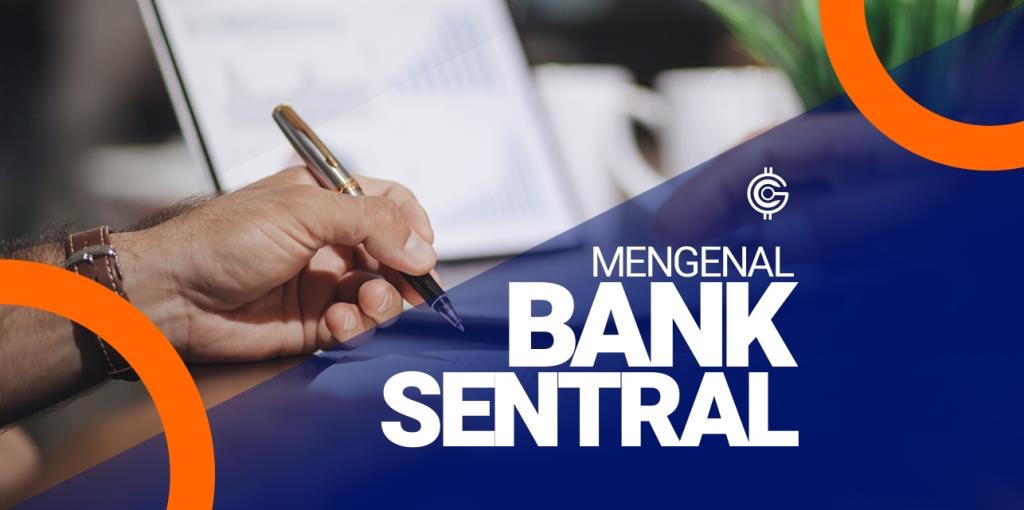In the banking of each country, of course, there are various types of banks that can be chosen by the public to make transactions regarding finance. Similar to Indonesia, in Indonesia itself there are various types of banks such as BNI, BRI, BCA, Mandiri, and others. However, there is one bank that oversees all banks in Indonesia. This
bank is called the Central Bank. The central bank is an institution of financial institutions in Indonesia whose own duties are handed over to Bank Indonesia. The central bank will be responsible for currency stability, banking sector stability, maintaining the inflation rate, and all finances in a country. For more details about the central bank itself, you can read the article below.
What is a central bank?
As mentioned earlier, a central bank is an institution or financial institution that has responsibility for a monetary policy and gives birth to a stable level of
economic activity in a country. The central bank is owned by a private party in a state government that has full and independent authority over the regulation and supervision of various activities of bank financial institutions in Indonesia. This central bank is interpreted as an institution that must be able to achieve and maintain the stability of the rupiah value. This is the reason why the central bank itself can be called an inflation rate controller. Law Number 3 of 2004 explains the definition of the Central Bank as a state institution that has the authority to issue legal tender from a country, formulate and implement monetary policy, regulate and supervise banking and carry out its function as a
lender of the last resort.
Duties of the Central Bank
This central bank has a task in its formation. The first is to establish and implement monetary policy. This authority includes setting discount rates, minimum reserves of commercial banks, setting monetary targets by paying attention to the rate of inflation, conducting monetary control without limitation to open market operations in the money market, and also implementing monetary policies to achieve and maintain rupiah stability. Second, the task of the central bank is to regulate and maintain the smooth running of the payment system. This task includes determining the use of payment instruments or instruments, implementing and giving approval for permits to operate payment system services, requiring payment system service providers to submit reports on their activities, and also being authorized to issue and circulate rupiah banknotes which include revoking, withdrawing, and destroying money from circulation. Third, the task of the central bank is to regulate and supervise banks. With duties including, imposing sanctions on banks in accordance with applicable laws and regulations, establishing regulations, granting and revoking licenses for certain institutions and business activities from banks, supervising banks, establishing banking provisions by upholding the principle of prudence aimed at achieving financial system stability.
Functions of Central Banks
There is also a function of the central bank to keep the payment system running smoothly. If there is an unexpected risk, then the function of Bank Indonesia itself is to prevent this from happening. As the central bank, Bank Indonesia must regulate the payment system mechanism that applies and is carried out by other financial institutions. Second, the central bank's function is as a research and monitoring actor. As Bank Indonesia is responsible for protecting financial stability from threats, Bank Indonesia must first obtain information on matters that endanger financial stability. Later, Bank Indonesia needs to conduct monitoring to find out if there are vulnerabilities in the financial sector as well as detect potential unexpected things in the financial system. Third, the function of the central bank is a place to store state cash. To carry out this function, Bank Indonesia coordinates with the Ministry of Finance. The coordination carried out starts from making reports, storing funds, issuing funds, to taking loans from abroad. And finally, the function of the central bank is to provide assistance to commercial banks so that they can escape the crisis. Every bank will certainly experience a crisis in its journey, both small and large. With this central bank, these banks can have a place to seek help. Bank Indonesia itself usually provides assistance in the form of funding. Therefore, Bank Indonesia will act as a safety net for the financial system or termed the
Lender of The Last Resort.
Central Bank Goals
This central bank has one single purpose. The goal of the central bank is to achieve and maintain rupiah stability. The stability of the rupiah value contains two aspects, namely, the stability of the value of the currency against goods and services, and the stability of the currency of other countries. This influencing aspect is reflected in the development of the inflation rate, while the second is reflected in the development of the rupiah exchange rate against other countries' currencies. This single objective is intended to clarify the objectives that Bank Indonesia must achieve and the limits of its responsibilities. With this, the achievement of these goals can be easily measured, whether it has been achieved, or it has not yet been implemented.
Central Banks of Developed Countries
Not only in Indonesia, but in other countries, of course, there are central banks that oversee every bank in their country. Especially in developed countries. The following are some of the central banks in developed countries in the world.
Federal Reserve (The Fed)
The central bank owned by the United States is the
Federal Reserve or commonly known as the Fed. This institution takes care of several financial policies, including the level of influence of personal interests, the balance of regional economic problems, the prevention of financial panic, and the type of reserves used to support the currency. This Federal Reserve Bank funds its own operations, primarily from the interest on its loans and the securities it owns. In addition, expenses and dividends paid are usually a small percentage of the Federal Reserve Bank's revenue each year. The functions and roles of this central bank of the Federal Reserve are, acting as depositors for bank reserves, lending to banks to cover short-term fund deficits, seasonal business cycles, or extraordinary liquidity requests, collecting and clearing interbank payments, issuing paper money for general circulation as currency, managing the federal government's deposit accounts, and also conducting auctions and repurchases of federal debt.
European Central Bank (ECB)
The central bank owned by countries in Europe is the
European Central Bank or commonly referred to as the ECB. The European Central Bank has authorization for the currency of the Eurozone. The ECB is one of the most influential central banks in the world besides the Federal Reserve Bank in the United States. The ECB itself oversees 120 central banks and commercial banks in member countries. The ECB and other central banks formed a Eurosystem that is useful for maintaining monetary stability and is responsible for aspects such as monetary policy, foreign exchange operations, euro area foreign currency reserves, and also the payment system. This European central bank also functions to maintain price stability and maintain the value of the euro. Like other central banks, the ECB has a monopoly on the issuance of money in the eurozone. The ECB does so by controlling the money available to central banks and commercial banks in eligible EU member states. In addition, the ECB also made an announcement of the benchmark interest rate and the amount of money supply. If banks in a member country have provided guarantees, they can then place their bids for ECB funds through an auction mechanism. Once banks get the funds, they will use them to provide loans to individuals and businesses.
Bank of England (BoE)
There is also the
Bank of England as one of the central banks of major currency countries which is also often the focus of attention of global financial markets. The BoE is the central bank of the United Kingdom which was established in 1694. The task of the BoE central bank itself is to be a monetary stabilizer and financial stability. Monetary stability is price stability and also the inflation rate, while financial stability is building a healthy and strong financial system as the key to economic growth in British countries. To help with the task of monetary stability, within the BoE formed the Monetary Policy Committee (MPC), a kind of FOMC in the Federal Reserve. Meanwhile, to help financial stability, there is a Financial Policy Committee (FPC) which was formed in June 2011. There are monetary policy instruments owned by the BoE central bank, such as interest rates, bond purchases, or their expansion, the Quantitative Easing (QE) program, and also other monetary policy instruments.
Bank of Japan (BoJ)
Meanwhile, in Japan, there is a central bank called the
Bank of Japan or commonly called the BoJ. The Bank of Japan has a monopoly on printing, distributing, and supervising the Yen. The Bank of Japan also has its own duties in the monetary field, namely, printing the yen currency and regulating and supervising its circulation, ensuring the stability of the financial system in Japan, implementing monetary policies necessary to achieve the inflation target, regulating the country's wealth portfolio such as gold reserves, foreign exchange, and other government securities, participating in international activities, and finally collecting various economic data and conducting research and analysis. The instruments used by the BoJ central bank itself are interest rates and also intervention on currency exchange rates.
Swiss National Bank (SNB)
Furthermore, there is the
Swiss National Bank which is the central bank in Switzerland. SNB itself has 4 official names that apply in Switzerland, namely, Schweizerische Nationalbank (Germany), Banque Nationale Suisse (France), Banca Nazionale Svizzera (Italy), and Bnca Naziunala Svizra (Roman). The SNB was established in 1907 and is independent and authorized in setting monetary policy, issuing the Swiss Franc (CHF), and keeping the Swiss economy running as expected. In addition, the SNB also makes payments on behalf of the Swiss government, stores and manages the government's foreign exchange reserves. The Executive Board of the Swiss National Bank is the board of governors responsible for monetary policy, asset management strategies, and financial system stability. The task of the Swiss National Bank is to maintain a level of price stability. In this case, the currency must be maintained at its fair exchange rate so that Switzerland can maintain optimal purchasing power. Central banks must be able to overcome the state of inflation or deflation that occurs by regulating interest rates. To maintain the inflation rate, the SNB makes changes to its monetary policy through instruments such as interest rates and other central bank policy tools. Usually every quarter, the SNB provides an inflation target forecast and sets interest rates based on the London Interbank Offered Rate (Libor) for a period of 3 months in the Swiss Franc.
Reserve Bank of Australia (RBA)
There is also the
Reserve Bank of Australia or commonly referred to as the RBA. The RBA is an Australian-owned central bank that began operating on January 14, 1960. This central bank is responsible for providing services to the Australian Government where bank profits are sent back, as well as providing services to other central banks and government institutions. The bank consists of the Payments System Board, which regulates all the bank's financial and banking policies. The Board is made up of members of banks, the finance department, other Australian government agencies, and leaders of other institutions that are part of the country's economy. Much like other central banks, the Reserve Bank of Australia's primary mission is to maintain the stability of the AUD currency, play a role in creating jobs, and improve economic growth and the welfare of Australian citizens. In carrying out this mission, the RBA takes policies such as determining the rate of interest rates in accordance with the medium-term inflation target, keeping the financial system solid, creating an efficient payment system, and issuing currency as a means of payment. In addition, the RBA oversees banking services on behalf of the Australian government, as well as managing gold and foreign currencies as foreign exchange reserves. In practice, the RBA focuses more on controlling the inflation rate through various policy adjustments. After knowing what a central bank is, its functions, duties, and objectives, as well as examples, it is hoped that later you will better understand how the central bank itself works and its mission. This is the discussion from
GICTrade regarding the explanation of "Central Bank Is". You can also find out other information about banking, investment, and other finance, such as "
Fintech Companies in Indonesia: Legal, Illegal Characteristics & Examples" only in the
GIC Journal. Also make sure you deepen your forex knowledge at GICTrade, via the
scalping ebook, and also
NFP live trading.

 Last:
Last: 






